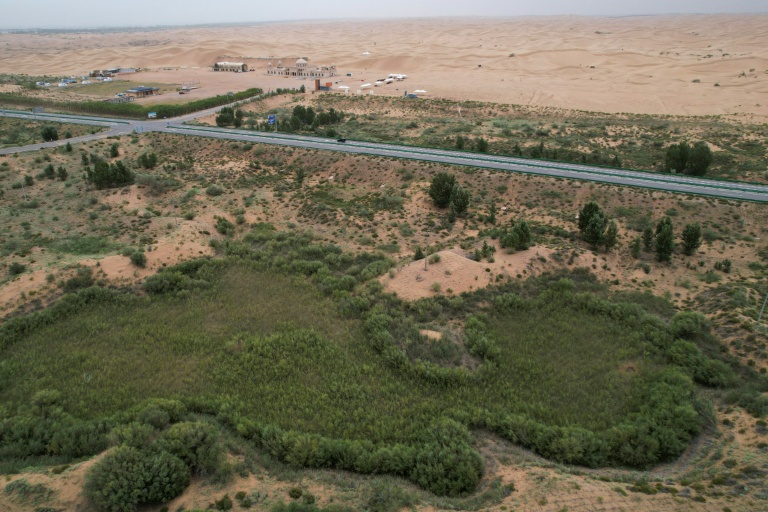World
China’s Great Green Wall Project: Progress and Controversy

The ambitious “Great Green Wall” initiative in China has sparked both optimism and challenges for local communities, particularly in Inner Mongolia. Originally aimed at combating desertification, the project has transformed over 90 million hectares of land, but it has also led to restrictions on traditional grazing practices that many herders, like Inner Mongolian resident Dorj, rely on for their livelihoods.
Launched decades ago, the campaign sought to mitigate the expansion of deserts resulting from intensive farming, mining, and climate change. The project has evolved to include not only extensive tree planting but also the introduction of drought-resistant plants and solar arrays to reduce wind and provide shade. Recently, during an international summit, President Xi Jinping reaffirmed China’s commitment to increasing forest cover to align with global climate goals.
While the initiative has created tens of thousands of jobs and alleviated poverty — as noted in a 2015 United Nations study — it has also led to significant cultural shifts among ethnic Mongolian communities, who make up 17 percent of Inner Mongolia’s population. For Dorj, the effects are stark; his flock has dwindled to around 20 sheep, confined to a limited area that he claims is inadequate for their needs.
Enghebatu Togochog, a Mongolian activist residing in exile in the United States, argues that the campaign has disconnected herders from their ancestral lands. He states, “The measures have forcibly displaced herders, severing their connection to the land and disrupting sustainable practices that maintained the grasslands’ delicate balance for millennia.” Traditional nomadic practices in Inner Mongolia have effectively diminished over the past decade, he asserts.
During a recent visit, reporters from AFP were closely monitored by local authorities, which limited their ability to engage with herders and gather firsthand accounts. This scrutiny has raised concerns about the freedom of expression in the region and the impact of government oversight on traditional lifestyles.
In a 2017 article, Chinese researchers acknowledged that the role of grazing in desertification might have been overstated. They pointed to ongoing issues such as mining, intensive agriculture, and climate change as contributing factors. The enforcement of grazing bans, coupled with dedicated patrols, has led to protests among herders and several arrests, according to various academic and non-governmental organizations.
Togochog criticized the greening project as part of a broader effort to transform the Mongolian landscape and lifestyle, claiming, “The sole beneficiaries are the Chinese — especially the state and the companies.” Despite repeated requests for comment, neither Elion Resources Group, the company overseeing the Kubuqi project, nor local authorities responded.
Experts in environmental science caution against the introduction of non-native, water-intensive plants in these greening efforts. Zhang Yanping, a scientist collecting samples in Kubuqi, highlighted potential ecological risks: “A plant that consumes too much water can deplete the water table and lead to further degradation.” Fellow geography professor Wang Shuai from Beijing Normal University emphasized the importance of maintaining desert ecosystems, stating, “Deserts have important ecological functions, like water conservation and biodiversity. It’s not necessary to eliminate them, just to prevent their expansion.”
The visual transformation of the landscape is evident, with large billboards promoting Xi’s philosophy that “Clear waters and green mountains are as valuable as gold and silver mountains.” Between 2016 and 2050, the Chinese government aims to plant an additional 70 million hectares of greenery, an area comparable to the size of continental France. Reports indicate that the Taklamakan Desert is now surrounded by vegetation, showcasing the project’s ambitious scope.
For some local farmers, the changes present new opportunities. Bai Lei, a farmer in Dengkou County, shared her success story, cultivating Cistanche, a plant valued in traditional Chinese medicine. “Before, everything here was desert,” she explained, gesturing to the vibrant fields of corn and sunflowers surrounding her farm. Bai’s business began over a decade ago and is part of a growing network of over 90 enterprises focused on this herb.
In contrast, Feng, a former farmer turned entrepreneur, now runs a successful quadbike rental business in an area undergoing greening. He contends that the grazing ban has increased available pastures and that grazing is permitted in designated areas once plants reach maturity. “Resources are more abundant, and our lives are more prosperous,” he said, reflecting a sentiment of pride and adaptability within the local community.
As the Great Green Wall initiative continues to unfold, it remains to be seen how the balance between environmental goals and the preservation of traditional lifestyles will be managed in Inner Mongolia. The complex interplay of progress and preservation highlights the need for careful consideration of both ecological and cultural impacts in such large-scale projects.
-

 Science3 months ago
Science3 months agoToyoake City Proposes Daily Two-Hour Smartphone Use Limit
-

 Top Stories3 months ago
Top Stories3 months agoPedestrian Fatally Injured in Esquimalt Collision on August 14
-

 Health3 months ago
Health3 months agoB.C. Review Reveals Urgent Need for Rare-Disease Drug Reforms
-

 Technology3 months ago
Technology3 months agoDark Adventure Game “Bye Sweet Carole” Set for October Release
-

 World3 months ago
World3 months agoJimmy Lai’s Defense Challenges Charges Under National Security Law
-

 Lifestyle3 months ago
Lifestyle3 months agoVictoria’s Pop-Up Shop Shines Light on B.C.’s Wolf Cull
-

 Technology3 months ago
Technology3 months agoKonami Revives Iconic Metal Gear Solid Delta Ahead of Release
-

 Technology3 months ago
Technology3 months agoApple Expands Self-Service Repair Program to Canada
-

 Technology3 months ago
Technology3 months agoSnapmaker U1 Color 3D Printer Redefines Speed and Sustainability
-

 Technology3 months ago
Technology3 months agoAION Folding Knife: Redefining EDC Design with Premium Materials
-

 Technology3 months ago
Technology3 months agoSolve Today’s Wordle Challenge: Hints and Answer for August 19
-

 Business3 months ago
Business3 months agoGordon Murray Automotive Unveils S1 LM and Le Mans GTR at Monterey









